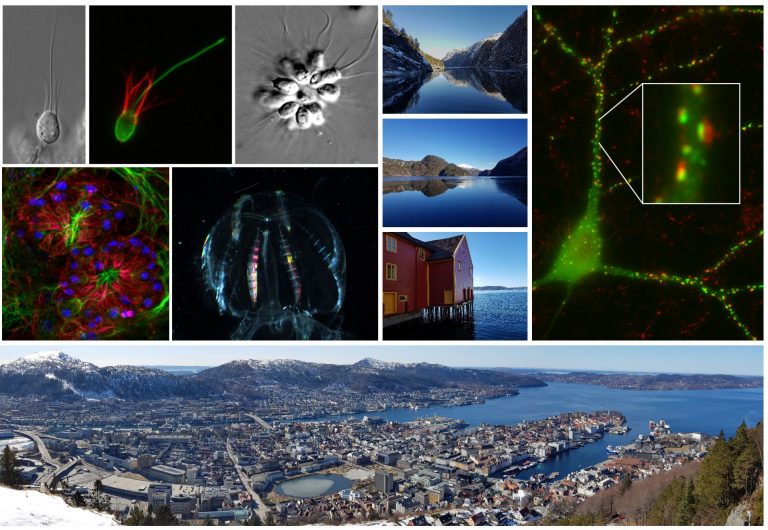April in preprints
Posted by the Node, on 1 May 2019
Welcome to our monthly trawl for developmental biology (and related) preprints.
This month was notable for a preponderance of plant development preprints, many molecular maps (supported by single cell sequencing), a hearty helping of human development and a multiplicity of (Drosophila) melanogaster mechanics.
The preprints were hosted on bioRxiv, PeerJ, and arXiv. Let us know if we missed anything, and use these links to get to the section you want:
Developmental biology
| Stem cells, regeneration & disease modelling
Evo-devo & evo
Cell biology
Modelling
Tools & resources
Research practice & education
Why not…
Developmental biology
| Patterning & signalling
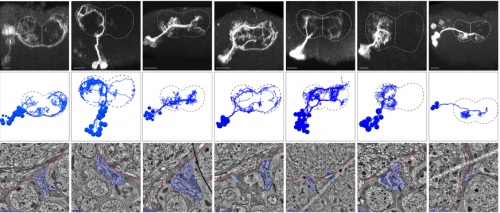
The role of lineage, hemilineage and temporal identity in establishing neuronal targeting and connectivity in the Drosophila embryo
Brandon Mark, Sen-Lin Lai, Aref Arzan Zarin, Laurina Manning, Albert Cardona, James W. Truman, Chris Q. Doe
A Drosophila larval premotor/motor neuron connectome generating two behaviors via distinct spatio-temporal muscle activity
Aref Arzan Zarin, Brandon Mark, Albert Cardona, Ashok Litwin-Kumar, Chris Q. Doe
Hairless as a novel component of the Notch signaling pathway
Steven W Miller, Artem Movsesyan, Sui Zhang, Rosa Fernández, James W Posakony
The Role of Sevenless in Drosophila R7 Photoreceptor Specification
Andrew Tomlinson, Yannis Emmanuel Mavromatakis, Ronald Arias
Multimodal transcriptional control of pattern formation in embryonic development
Nicholas C Lammers, Vahe Galstyan, Armando Reimer, Sean A Medin, Chris H Wiggins, Hernan G Garcia
Makorin 1 controls embryonic patterning by alleviating Bruno1-mediated repression of oskar translation
Annabelle Dold, Hong Han, Niankun Liu, Andrea Hildebrandt, Mirko Brüggemann, Cornelia Rücklé, Anke Busch, Petra Beli, Kathi Zarnack, Julian König, Jean-Yves Roignant, Paul Lasko
Eiger/TNFα-mediated Dilp8 and ROS production coordinate intra-organ growth in Drosophila
Juan A. Sanchez, Duarte Mesquita, María C. Ingaramo, Federico Ariel, Marco Milán, Andrés Dekanty
Drosophila insulin-like peptide 1 (DILP1) promotes organismal growth and catabolic energy metabolism during the non-feeding pupal stage
Sifang Liao, Stephanie Post, Philipp Lehmann, Jan A Veenstra, Marc Tatar, Dick R Nassel
Differential Metabolic Sensitivity of mTORC1- and mTORC2-Dependent Overgrowth
Maelle Devilliers, Damien Garrido, Mickael Poidevin, Thomas Rubin, Arnaud Le Rouzic, Jacques Montagne
Drosophila adult muscle precursor cells contribute to motor axon pathfinding and proper innervation of embryonic muscles
Guillaume Lavergne, Krzysztof Jagla
Yorkie and JNK revert syncytial muscles into myoblasts during Org-1 dependent lineage reprogramming
Christoph Schaub, Marcel Rose, Manfred Frasch

Induction of Chk2 signaling in the germarium is sufficient to cause oogenesis arrest in Drosophila
Zeljko Durdevic, Anne Ephrussi
Trans-synaptic Fish-lips Signaling Prevents Misconnections between Non-synaptic Partner Olfactory Neurons
Qijing Xie, Bing Wu, Jiefu Li, Hongjie Li, David J Luginbuhl, Chuanyun Xu, Xin Wang, Liqun Luo
Altered levels of hsromega lncRNAs further enhance Ras signaling during ectopically activated Ras induced R7 differentiation in Drosophila
Mukulika Ray, Gunjan Singh, Subhash C. Lakhotia
A direct glia-to-neuron natural transdifferentiation ensures nimble sensory-motor coordination of male mating behaviour
Laura Molina-Garcia, Byunghyuk Kim, Steven J Cook, Rachel Bonnington, Jack O’Shea, Michele Sammut, Sophie P R Gilbert, David Elliott, David H Hall, Scott W Emmons, Arantza Barrios, Richard J Poole
Epigenetic bookmarking of H2S exposure in Caenorhabditis elegans
Emily M Fawcett, Jenna K Johnson, Chris Braden, Esteli M Garcia, Dana L Miller
Effects of sugars and lipids on the growth and development of Caenorhabditis elegans
Xiong Wang, Lin Zhang, Lei Zhang, Wenli Wang, Sihan Wei, Jie Wang, Huilian Che, Yali Zhang
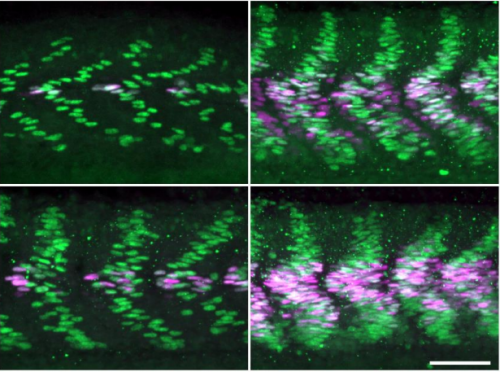
Zebrafish GPR161 Contributes to Basal Hedgehog Repression in a Tissue-specific Manner
Philipp Tschaikner, Dominik Regele, Willi Salvenmoser, Stephan Geley, Eduard Stefan, Pia Aanstad
GABA-A signaling maintains melanocyte stem cell quiescence in larval zebrafish
James R. Allen, James B. Skeath, Stephen L. Johnson
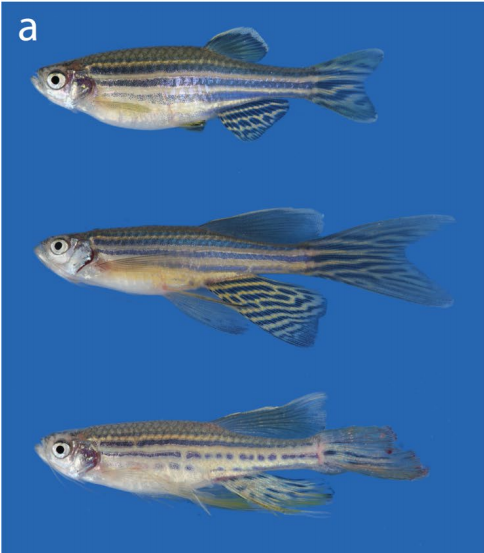
Integrated K+ channel and K+-Cl− cotransporter functions regulate fin proportionality in zebrafish
Jennifer S. Lanni, David Peal, Laura Ekstrom, Haining Chen, Caroline Stanclift, Margot Bowen, Adriana Mercado, Gerardo Gamba, Kristopher T. Kahle, Matthew P. Harris
Large-scale death of retinal astrocytes during normal development mediated by microglia
Vanessa M. Puñal, Caitlin E. Paisley, Federica S. Brecha, Monica A. Lee, Robin M. Perelli, Emily G. O’Koren, Caroline R. Ackley, Daniel R. Saban, Benjamin E. Reese, Jeremy N. Kay
A combination of running and memantine increases neurogenesis and reduces activation of developmentally-born dentate granule neurons in rats
Shaina P. Cahill, Angela Martinovic, John Darby Cole, Jason S. Snyder
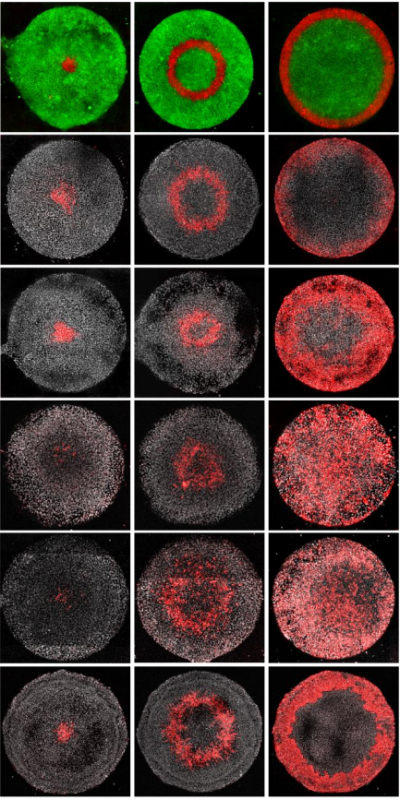
Mapping cell migrations and fates from a gastruloid model to the human primitive streak
I. Martyn, E.D. Siggia, A.H. Brivanlou
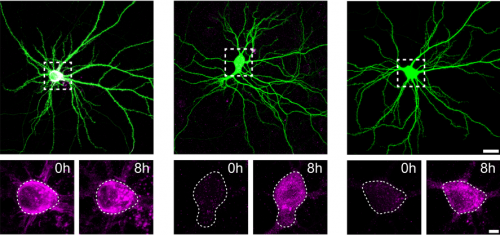
The human-specific paralogs SRGAP2B and SRGAP2C differentially modulate SRGAP2A-dependent synaptic development
Ewoud R.E. Schmidt, Justine V. Kupferman, Michelle Stackmann, Franck Polleux
ERK1/2 signalling dynamics promote neural differentiation by regulating the polycomb repressive complex
Claudia I. Semprich, Vicki Metzis, Harshil Patel, James Briscoe, Kate G. Storey
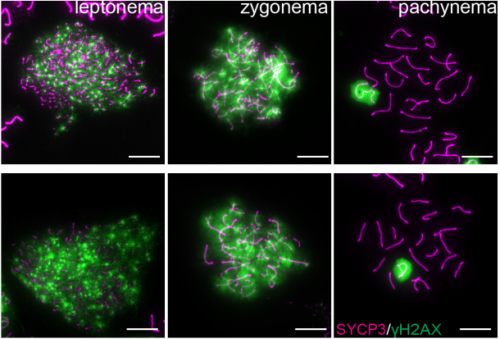
Cyclin B3 is dispensable for mouse spermatogenesis
Mehmet E. Karasu, Scott Keeney
Pregnancy-associated plasma protein-aa supports hair cell survival by regulating mitochondrial function
Mroj Alassaf, Emily Daykin, Jaffna Mathiaparanam, Marc Wolman
Dorsal-to-ventral neocortical expansion is physically primed by ventral streaming of early embryonic preplate neurons
Kanako Saito, Mayumi Okamoto, Yuto Watanabe, Namiko Noguchi, Arata Nagasaka, Yuta Nishina, Tomoyasu Shinoda, Akira Sakakibara, Takaki Miyata
Canonical NOTCH signaling controls the early progenitor state and emergence of the medullary epithelial lineage in fetal thymus development
Dong Liu, Anastasia I. Kousa, Kathy E. O’Neill, Francois Guillemot, Martyna Popis, Alison M. Farley, Simon R. Tomlinson, Svetlana Ulyanchenko, Philip A. Seymour, Palle Serup, Ute Koch, Freddy Radtke, C. Clare Blackburn
NOTCH1 signaling establishes the medullary thymic epithelial cell progenitor pool during mouse fetal development
Jie Li, Julie Gordon, Edward L. Y. Chen, Luying Wu, Juan Carlos Zúñiga-Pflücker, Nancy R. Manley
Apoptosis in the fetal testis eliminates developmentally defective germ cell clones
Daniel H. Nguyen, Diana J. Laird
RUNX1 safeguards the identity of the fetal ovary through an interplay with FOXL2
Barbara Nicol, Sara A. Grimm, Frederic Chalmel, Estelle Lecluze, Maëlle Pannetier, Eric Pailhoux, Elodie Dupin-De-Beyssat, Yann Guiguen, Blanche Capel, Humphrey H.-C. Yao
Chemically-defined induction of a primitive endoderm and epiblast-like niche supports post-implantation progression from blastoids
Erik J. Vrij, Yvonne S. Scholte op Reimer, Javier Frias Aldeguer, Isabel Misteli Guerreiro, Jop Kind, Bon-Kyoung Koo, Clemens A. van Blitterswijk, Nicolas C. Rivron
N-Glycome regulation limits the transdifferentiation of endothelial cells into hematopoietic stem cells
Dionna M. Kasper, Yinyu Wu, Hanna K. Mandl, Kevin Salinas, Joey Ghersi, Jared Hintzen, William Armero, Zhiheng He, Daniel W. Heindel, Eon Joo Park, William C. Sessa, Lara K. Mahal, Karen K. Hirschi, Stefania Nicoli
Loss of adipocyte identity through synergistic repression of PPARγ by TGF-β and mechanical stress
Ewa Bielczyk-Maczyńska, Brooks Taylor, Cayla M Miller, Michael L Zhao, Arnav Shah, Zahra Bahrami-Nejad, Alexander R Dunn, Mary N Teruel
Greater loss of female embryos during human pregnancy: A novel mechanism
John F Mulley
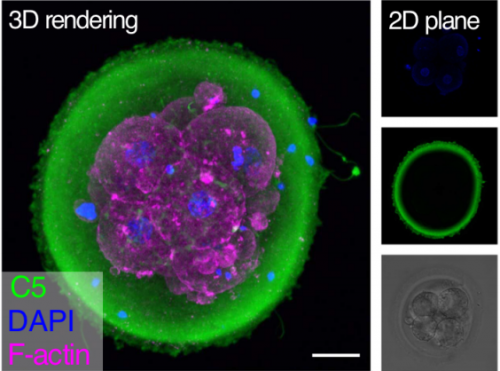
Complement in human pre-implantation embryos: attack and defense
Martin P. Reichhardt, Karolina Lundin, A. Inkeri Lokki, Gaëlle Recher, Sanna Vuoristo, Shintaro Katayama, Juha Tapanainen, Juha Kere, Seppo Meri, Timo Tuuri
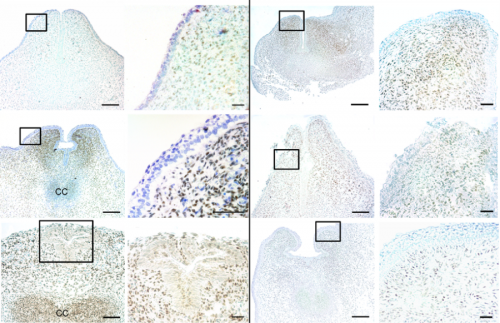
Alternative pathway androgen biosynthesis and human fetal female virilization
Nicole Reisch, Angela E Taylor, Edson F Nogueiras, Daniel J Asby, Vivek Dhir, Andrew Berry, Nils P Krone, Richard J Auchus, Cedric HL Shackleton, Neil A Hanley, Wiebke Arlt
Longitudinal white matter development in children is associated with puberty, attentional difficulties, and mental health
Sila Genc, Charles B Malpas, Alisha Gulenc, Emma Sciberras, Daryl Efron, Timothy J Silk, Marc L Seal
Slc7a11 modulated by POU2F1 is involved in pigmentation in rabbit
Yang Chen, Shuaishuai Hu, Lin Mu, Bohao Zhao, Manman Wang, Naisu Yang, Guolian Bao, Cigen Zhu, Xinsheng Wu
Androgen-dmrt1 positive feedback programs the rice field eel (Monopterus albus) sex transdifferentiation
Bin Wen, Xiancheng Qu, Lisha Pan, Jianzhong Gao, Haowei Wu, Qian Wang
Nix confers heritable sex-conversion in Aedes aegypti and myo-sex is needed for male flight
Azadeh Aryan, Michelle Anderson, James K. Biedler, Yumin Qi, Justin M. Overcash, Anastasia N. Naumenko, Maria V. Sharakhova, Chunhong Mao, Zach N. Adelman, Zhijian Tu
| Morphogenesis & mechanics
The Drosophila Afadin and ZO-1 homologs Canoe and Polychaetoid act in parallel to maintain epithelial integrity when challenged by adherens junction remodeling
Lathiena Manning, Kia Perez-Vale, Kristina Schaefer, Mycah Sewell, Mark Peifer

Rho-kinase planar polarisation at tissue boundaries depends on phospho-regulation of membrane residence time
Clara Sidor, Tim J. Stevens, Li Jin, Jérôme Boulanger, Katja Röper
The RhoGEF Cysts couples apical polarity proteins to Rho and myosin activity at adherens junctions
Jordan T. Silver, Frederik Wirtz-Peitz, Sérgio Simões, Milena Pellikka, Dong Yan, Richard Binari, Takashi Nishimura, Yan Li, Tony J. C. Harris, Norbert Perrimon, Ulrich Tepass
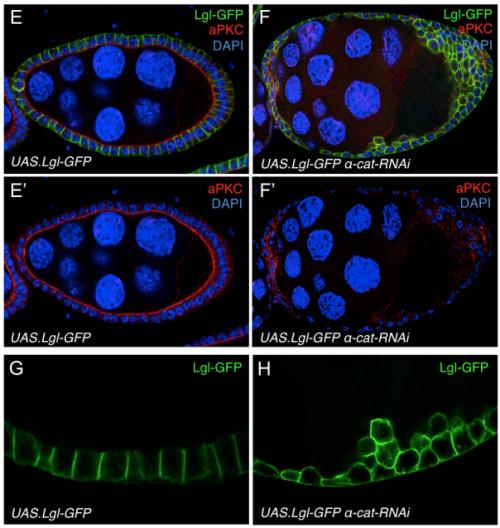
A fence function for adherens junctions in epithelial cell polarity
Mario Aguilar-Aragon, Alex Tournier, Barry J Thompson
Mask family proteins ANKHD1 and ANKRD17 regulate YAP nuclear import, stability and phase separation
Clara Sidor, Nerea Borreguero-Munoz, Georgina C Fletcher, Ahmed Elbediwy, Hannah Vanyai, Oriane Guillermin, Barry J Thompson
Tissue specific vulnerability to mitotic defects caused by mutations in the Drosophila ASPM homologue, Asp
Lori Borgal, Margaux Quiniou, James Wakefield
Tissue Mechanics Determines Cell Fate in the Axial Stem Zones
Timothy R Wood, Anders R Kyrsting, Johannes Stegmaier, Iwo Kucinski, Clemens F Kaminski, Ralf Mikut, Octavian Voiculescu
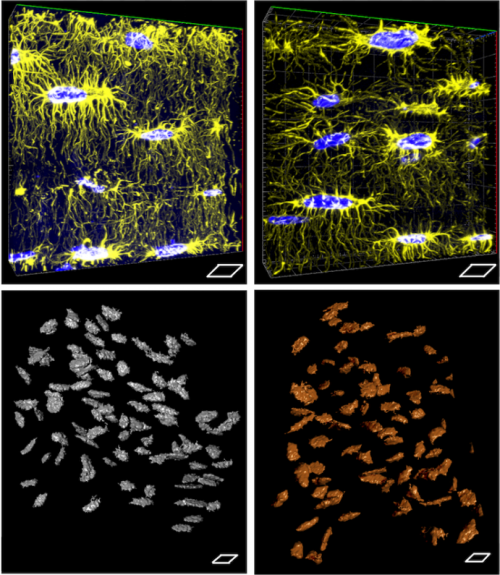
Osteocytes remodel bone by TGF-β-induced YAP/TAZ signaling
Christopher D. Kegelman, Jennifer C. Coulombe, Kelsey M. Jordan, Daniel J. Horan, Ling Qin, Alexander G. Robling, Virginia. L Ferguson, Teresita M. Bellido, Joel D. Boerckel
The desmosomal cadherin Desmogon is necessary for the structural integrity of the Medaka notochord
Ali Seleit, Karen Groß, Michaela Wölk, Camilla Autorino, Lazaro Centanin
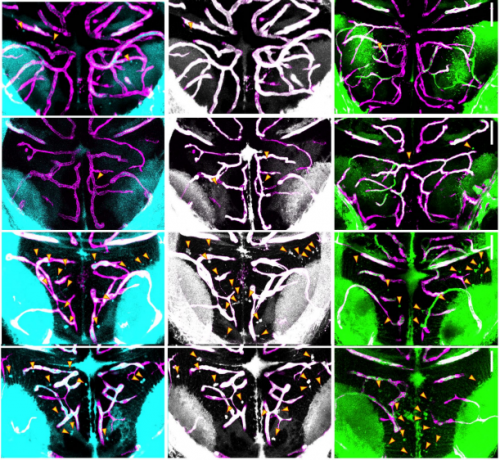
Suppression of transcytosis regulates zebrafish blood-brain barrier development
Natasha M. O’Brown, Sean G. Megason, Chenghua Gu
Segregated neural explants exhibit co-oriented, asymmetric, neurite outgrowth
David B. Pettigrew, Curtis B. Dobson, Lori G. Isaacson, Eric Leuthardt, Heather Lilley, Georgette Suidan, Keith A. Crutcher
| Genes & genomes
Developmentally regulated Shh expression is robust to TAD perturbations
Iain Williamson, Lauren Kane, Paul S Devenney, Eve Anderson, Fiona Kilanowski, Robert E Hill, Wendy Bickmore, Laura Lettice
In vivo Firre and Dxz4 deletion elucidates roles for autosomal gene regulation
Daniel Andergassen, Zachary D. Smith, Jordan P. Lewandowski, Chiara Gerhardinger, Alexander Meissner, John L. Rinn
Developmentally regulated tcf7l2 splice variants mediate transcriptional repressor functions during eye formation
Rodrigo M. Young, Kenneth B. Ewan, Veronica P. Ferrer, Miguel L. Allende, Trevor C. Dale, Stephen W. Wilson

Sox1a mediates the ability of the parapineal to impart habenular left-right asymmetry
Ingrid Lekk, Véronique Duboc, Ana Faro, Stephanos Nicolaou, Patrick Blader, Stephen W. Wilson
miR-9 mediated noise optimization of the her6 oscillator is needed for cell state progression in the Zebrafish hindbrain
Ximena Soto, Veronica Biga, Jochen Kursawe, Robert Lea, Parnian Doostdar, Nancy Papalopulu
Epigenetic regulation of unique genes and repetitive elements by the KRAB zinc finger protein ZFP57
Hui Shi, Ruslan Strogantsev, Nozomi Takahashi, Anastasiya Kazachenka, Matthew C. Lorincz, Myriam Hemberger, Anne C. Ferguson-Smith
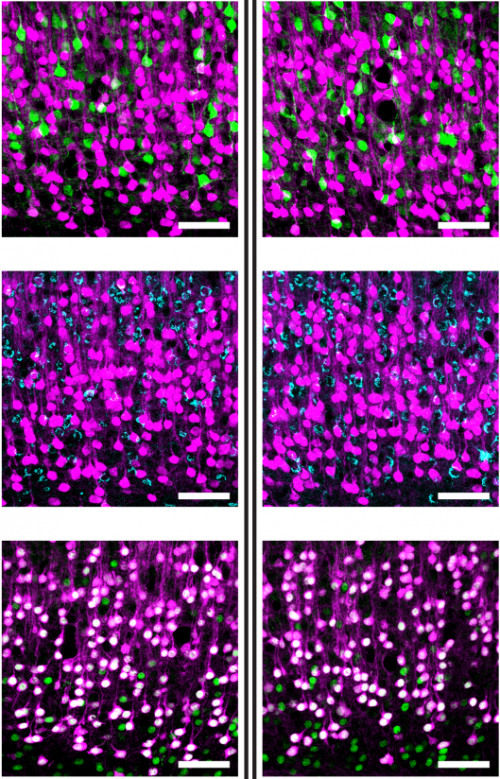
FOXP2 exhibits projection neuron class specific expression, but is not required for multiple aspects of cortical histogenesis
Ryan J Kast, Alexandra L Lanjewar, Colton D Smith, Pat Levitt
A distinct cardiopharyngeal mesoderm genetic hierarchy establishes antero-posterior patterning of esophagus striated muscle
Glenda Comai, Églantine Heude, Sebastien Mella, Sylvain Paisant, Francesca Pala, Mirialys Gallardo, Gabrielle Kardon, Swetha Gopalakrishnan, Shahragim Tajbakhsh
Single-cell analysis of Foxp1-driven mechanisms essential for striatal development
Ashley G. Anderson, Ashwinikumar Kulkarni, Matthew Harper, Genevieve Konopka

A Single-cell Transcriptomic Atlas of the Developing Chicken Limb
Christian Feregrino, Fabio Sacher, Oren Parnas, Patrick Tschopp
A 3D molecular atlas of the chick embryonic heart
Claire Anderson, Bill Hill, Hui-Chun Lu, Adam Moverley, Youwen Yang, Nidia M.M. Oliveira, Richard A. Baldock, Claudio D. Stern
Dissecting the cellular specificity of smoking effects and reconstructing lineages in the human airway epithelium
Katherine C. Goldfarbmuren, Nathan D. Jackson, Satria P. Sajuthi, Nathan Dyjack, Katie S. Li, Cydney L. Rios, Elizabeth G. Plender, Michael T. Montgomery, Jamie L. Everman, Eszter K. Vladar, Max A. Seibold
Single cell RNA-seq reveals cellular diversity and developmental characteristics of human infant retina
Jixing Zhong, Dongsheng Chen, Fangyuan Hu, Fang Chen, Zaoxu Xu, Jian Fang, Jianjiang Xu, Shiyou Wang, Langchao Liang, Chaochao Chai, Xiangning Ding, Jiacheng Zhu, Peiwen Ding, Jun Xia, Sanjie Jiang, Wei Li, Ya Gao, Jianguo Zhang, Jiankang Li, Ping Xu, Fengjuan Gao, Dandan Wang, Daowei Zhang, Jie Huang, Shoufang Qu, Shenghai Zhang, Jihong Wu, Xinghuai Sun
GPIF constrains Polycomb Repressive Complex 2 activity in germ cells
R Ragazzini, R Pérez-Palacios, HI Baymaz, D Zielinski, A Michaud, M Givelet, M Borsos, PWTC Jansen, N Servant, ME Torres-Padilla, D Bourc’his, P Fouchet, M Vermeulen, R Margueron
Maintenance of spatial gene expression by Polycomb-mediated repression after formation of a vertebrate body plan
Julien Rougeot, Naomi D. Chrispijn, Marco Aben, Dei M. Elurbe, Karolina M. Andralojc, Patrick J. Murphy, Pascal W.T.C. Jansen, Michiel Vermeulen, Bradley R. Cairns, Leonie M. Kamminga
FGF/MAPK signaling pathway regulates the genome-wide occupancy of Polycomb Repressive Complex 2 in murine embryonic stem cells
Mohammad B. Aljazi, Yuen Gao, Yan Wu, George I. Mias, Jin He
PRDM1 controls the sequential activation of neural, neural crest and sensory progenitor determinants by regulating histone modification
Ravindra S. Prajapati, Mark Hintze, Andrea Streit
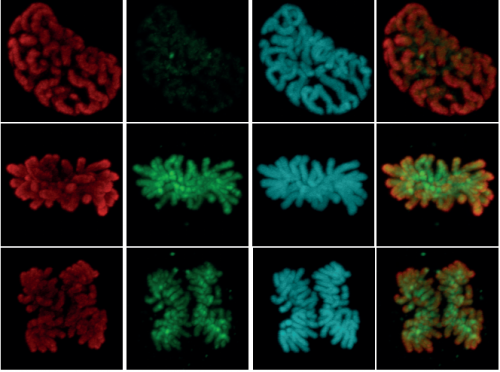
Regardless of the deposition pathway, aminoacid 31 in histone variant H3 is essential at gastrulation in Xenopus
David Sitbon, Ekaterina Boyarchuk, Geneviève Almouzni
Normal development and fertility of Fut1, Fut2, and Sec1 triple knockout mice
Jiaxi Chen, Zhipeng Su, Chunlei Zhang, Fenge Li, Patrick Hwu, Zhen Wang, Yanping Wang, Yunsen Li, Jiao Tong, Chunchao Chen, Dapeng Zhou
Telomere dysfunction represses HNF4α leading to impaired hepatocyte development and function
Evandro L. Niero, Wilson C. Fok, Alexandre T. Vessoni, Kirsten A. Brenner, Luis F.Z. Batista
A network of microRNAs acts to promote cell cycle exit and differentiation of human pancreatic endocrine cells
Wen Jin, Francesca Mulas, Bjoern Gaertner, Yinghui Sui, Jinzhao Wang, Chun Zeng, Nicholas Vinckier, Allen Wang, Kim-Vy Nguyen-Ngoc, Joshua Chiou, Klaus H. Kaestner, Kelly Frazer, Andrea C. Carrano, Hung-Ping Shih, Maike Sander
Developmental and cell-specific expression of Cacna1d splice variants
LaCarubba Brianna, Bunda Alexandra, Savage Kitty, Sargent Hannah, Akiki Marie, Foxall Thomas, Andrade Arturo
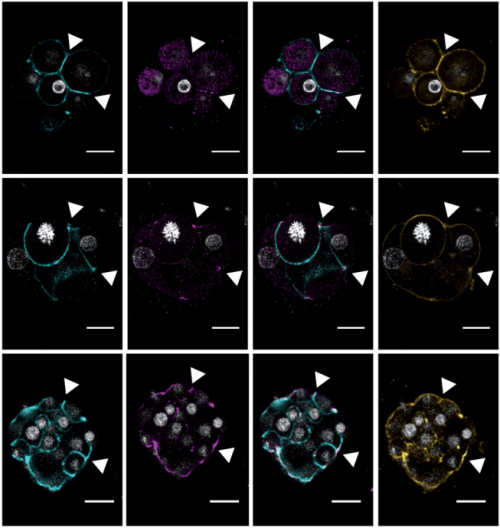
Spatio-temporal analysis of human preimplantation development reveals dynamics of epiblast and trophectoderm
Dimitri Meistermann, Sophie Loubersac, Arnaud Reignier, Julie Firmin, Valentin Francois Campion, Stéphanie Kilens, Yohann Lelièvre, Jenna Lammers, Magalie Feyeux, Phillipe Hulin, Steven Nedellec, Betty Bretin, Simon Covin, Gael Castel, Audrey Bihouée, Magali Soumillon, Tarjei Mikkelsen, Paul Barrière, Jérémie Bourdon, Thomas Fréour, Laurent David
The RNA binding protein DAZL functions as repressor and activator of maternal mRNA translation during oocyte maturation
Cai-Rong Yang, Gabriel Rajkovic, Enrico Maria Daldello, Xuan G. Luong, Jing Chen, Marco Conti
Chromatin co-accessibility is highly structured, spans entire chromosomes, and mediates long range regulatory genetic effects
William W. Young Greenwald, Agnieszka D’Antonio-Chronowska, Paola Benaglio, Hiroko Matsui, Erin N. Smith, Matteo D’Antonio, Kelly A. Frazer
CTCF binding strength modulates chromatin architecture through the changes of the local nucleosome repeat length
Christopher T. Clarkson, Emma A. Deeks, Ralph Samarista, Victor B. Zhurkin, Vladimir B. Teif
Pre-marked chromatin and transcription factor co-binding shape the pioneering activity of Foxa2
Filippo M. Cernilogar, Stefan Hasenöder, Zeyang Wang, Katharina Scheibner, Ingo Burtscher, Michael Sterr, Pawel Smialowski, Sophia Groh, Ida M. Evenroed, Gregor D. Gilfillan, Heiko Lickert, Gunnar Schotta
Stochastic gene expression is optimized to drive developmental self-organization
Ritika Giri, Dimitrios K. Papadopoulos, Diana M. Posadas, Hemanth K. Potluri, Pavel Tomancak, Madhav Mani, Richard W. Carthew
The histone demethylase KDM5 controls developmental timing in Drosophila by promoting prothoracic gland endocycles
Coralie Drelon, Helen M. Belalcazar, Julie Secombe
Polymer coil-globule phase transition is a universal folding principle of Drosophila epigenetic domains
Antony Lesage, Vincent Dahirel, Jean-Marc Victor, Maria Barbi
RNA transcribed from heterochromatic simple-tandem repeats are required for male fertility and histone-protamine exchange in Drosophila melanogaster
Wilbur K Mills, Yuh Chwen G. Lee, Antje M Kochendoerfer, Elaine M Dunleavy, Gary H. Karpen
BEN-solo factors partition active chromatin to ensure proper gene activation in Drosophila
Malin Ueberschär, Huazhen Wang, Chun Zhang, Shu Kondo, Tsutomu Aoki, Paul Schedl, Eric C. Lai, Jiayu Wen, Qi Dai
Elav-mediated exon skipping and alternative polyadenylation of the Dscam1 gene is required for axon outgrowth
Z. Zhang, K. So, R. Peterson, M. Bauer, H. Ng, Y. Zhang, J.H. Kim, T. Kidd, P. Miura
Drosophila ribosomal protein S5b is essential for oogenesis and interacts with distinct RNAs
Jian Kong, Hong Han, Julie Bergalet, Louis Philip Benoit Bouvrette, Greco Hernández, Nam-Sung Moon, Hojatollah Vali, Éric Lécuyer, Paul Lasko
The nascent RNA binding complex SFiNX licenses piRNA-guided heterochromatin formation
Julia Batki, Jakob Schnabl, Juncheng Wang, Dominik Handler, Veselin I. Andreev, Christian E. Stieger, Maria Novatchkova, Lisa Lampersberger, Kotryna Kauneckaite, Wei Xie, Karl Mechtler, Dinshaw J. Patel, Julius Brennecke
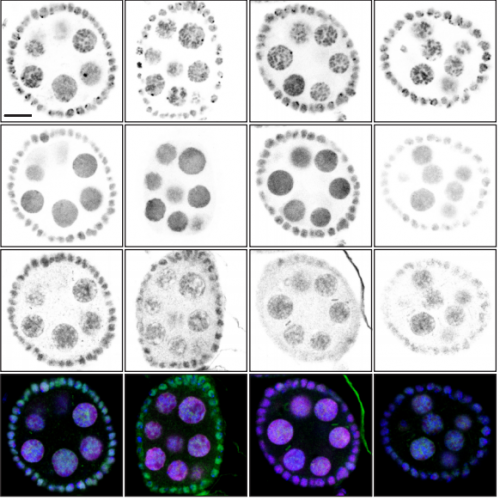
piRNA-guided co-transcriptional silencing coopts nuclear export factors
Martin H. Fabry, Filippo Ciabrelli, Marzia Munafò, Evelyn L. Eastwood, Emma Kneuss, Ilaria Falciatori, Federica A. Falconio, Gregory J. Hannon, Benjamin Czech
Effect of heritable symbionts on maternally-derived embryo transcripts
Mariana Mateos, Nadisha O. Silva, Paulino Ramirez, Victor M. Higareda-Alvear, Rodolfo Aramayo, James W. Erickson
Binding of an X-specific condensin correlates with a reduction in active histone modifications at gene regulatory elements
Lena Annika Street, Ana Karina Morao, Lara Heermans Winterkorn, Chen-Yu Jiao, Sarah Elizabeth Albritton, Mohammed Sadic, Maxwell Kramer, Sevinç Ercan
The knockout of the HMG-Box Domain of the porcine SRY-gene by CRISPR/Cas RNP microinjection causes sex reversal in gene-edited pigs
Stefanie Kurtz, Antje Frenzel, Andrea Lucas-Hahn, Petra Hassel, Roswitha Becker, Maren Ziegler, Monika Nowak-Imialek, Brigitte Schlegelberger, Gudrun Göhring, Heiner Niemann, Björn Petersen
| Stem cells, regeneration & disease modelling
G2M splits mouse embryonic stem cells into naïve and formative pluripotency states
Kersti Jääger, Daniel Simpson, Maria Kalantzaki, Angela Salzano, Ian Chambers, Tamir Chandra
Regulation of Cyclin E by transcription factors of the naïve pluripotency network in mouse embryonic stem cells
Fabrice Gonnot, Diana Langer, Pierre-Yves Bourillot, Nathalie Doerflinger, Pierre Savatier

Dissecting mechanisms of human islet differentiation and maturation through epigenome profiling
Juan R. Alvarez-Dominguez, Julie Donaghey, Jennifer H. R. Kenty, Niloofar Rasouli, Aharon Helman, Jocelyn Charlton, Juerg R. Straubhaar, Alexander Meissner, Douglas A. Melton
Long noncoding RNAs sustain high expression of exogenous Oct4 by sponging miRNA during reprogramming
Qingran Kong, Xiaolei Zhang, Jiaming Zhang, Kailun Zheng, Heng Zhang, Xixiang Pei, Zhi Yin, Duancheng Wen, Zhonghua Liu
Control of glioblastoma differentiated-to-stem cell reprogramming by IRE1α/XBP1s signaling.
Dimitrios Doultsinos, Mari McMahon, Konstantinos Voutetakis, Joanna Obacz, Raphael Pineau, Florence Jouan, Pierre-Jean Le Reste, Akram Obiedat, Juhi Samal, John B Patterson, Quinping Zheng, Afshin Samali, Abhay Pandit, Boaz Tirosh, Aristotelis Chatziioannou, Eric Chevet, Tony Avril
Nanog regulates Pou3f1 expression and represses anterior fate at the exit from pluripotency
Antonio Barral, Isabel Rollan, Hector Sanchez-Iranzo, Wajid Jawaid, Claudio Badia-Careaga, Sergio Menchero, Manuel Gomez-Rodriguez, Carlos Torroja, Fatima Sanchez-Cabo, Berthold Göttgens, Miguel Manzanares, Julio Sainz de Aja
High fat diet induces a microbiota-dependent increase in stem cell activity in the Drosophila intestine
Jakob von Frieling, Muhammed Naeem Faisal, Femke Sporn, Roxana Pfefferkorn, Felix Sommer, Philip Rosenstiel, Thomas Roeder
A Comprehensive Molecular Portrait of Human Urine-derived Renal Progenitor Cells
Md Shaifur Rahman, Wasco Wruck, Lucas-Sebastian Spitzhorn, Martina Bohndorf, Soraia Martins, Fatima Asar, Audrey Ncube, Lars Erichsen, Nina Graffmann, James Adjaye
Pluripotent Stem Cells Can Be Isolated from Human Peripheral Nerves after in vitro BMP-2 Stimulation
Ren-Yi Sun, Michael H. Heggeness, Tanghong Jia, Sunaina Shrestha, Bradley Dart, Shang-You Yang
Redox potential defines functional states of adult hippocampal stem cells
Vijay S Adusumilli, Tara L Walker, Rupert W Overall, Gesa M Klatt, Salma A Zeidan, Tim J Fischer, Sara Zocher, Alex M Sykes, Susanne Reinhardt, Andreas Dahl, Dilyana G Kirova, Jörg Mansfeld, Annette E Rünker, Gerd Kempermann
Neogenin-1 distinguishes between myeloid-biased and balanced Hoxb5+ long-term hematopoietic stem cells
Gunsagar Singh Gulati, Monika Zukowska, Joseph Noh, Allison Zhang, Rahul Sinha, Benson George, Daniel Wesche, Irving L Weissman, Krzysztof Szade
Deciphering the protein dynamics and molecular determinants of iPSC-derived neurons
Suzy Varderidou-Minasian, Philipp Schätzle, Casper. C. Hoogenraad, R. Jeroen Pasterkamp, Maarten Altelaar

Single cell transcriptome analysis reveals markers of naïve and lineage-primed hematopoietic progenitors derived from human pluripotent stem cells
Antonella Fidanza, Nicola Romanò, Prakash Ramachandran, Sara Tamagno, Martha Lopez-Yrigoyen, Alice Helen Taylor, Jennifer Easterbrook, Beth Henderson, Richard Axton, Neil Cowan Henderson, Alexander Medvinsky, Katrin Ottersbach, Lesley Margaret Forrester LM
Use of human iPSCs and kidney organoids to develop a cysteamine/mTOR inhibition combination therapy to treat cystinosis
Jennifer A. Hollywood, Aneta Przepiorski, Patrick T. Harrison, Ernst J. Wolvetang, Alan J. Davidson, Teresa M. Holm
Identification of a basal stem cell subpopulation in the prostate via functional, lineage tracing and single-cell RNA-seq analyses
Xue Wang, Haibo Xu, Chaping Cheng, Zhongzhong Ji, Huifang Zhao, Yaru Sheng, Xiaoxia Li, Jinming Wang, Yu Shu, Yuman He, Liancheng Fan, Baijun Dong, Wei Xue, Chee Wai Chua, Dongdong Wu, Wei-Qiang Gao, Helen He Zhu
Generation of human hepatic progenitor cells with regenerative and metabolic capacities from primary hepatocytes
Takeshi Katsuda, Juntaro Matsuzaki, Tomoko Yamaguchi, Yasuhiro Yamada, Kazunori Hosaka, Atsuko Takeuchi, Yoshimasa Saito, Takahiro Ochiya
Role of human induced pluripotent stem cell-derived spinal cord astrocytes in the functional maturation of motor neurons in a multielectrode array system
Arens Taga, Raha Dastgheyb, Christa Habela, Jessica Joseph, Jean-Philippe Richard, Sarah K. Gross, Giuseppe Lauria, Gabsang Lee, Norman Haughey, Nicholas J. Maragakis
The gene brain tumor constrains growth to ensure proper patterning during regeneration in Drosophila imaginal discs
Syeda Nayab Fatima Abidi, Rachel K. Smith-Bolton
Transpositional scaling and niche transitions restore organ size and shape during zebrafish fin regeneration
Scott Stewart, Gabriel A. Yette, Astra L. Henner, Heather K. Le Bleu, Joshua A. Braunstein, Jad W. Chehab, Michael J. Harms, Kryn Stankunas
Estrogen accelerates heart regeneration by promoting inflammatory responses in zebrafish
Shisan Xu, Fangjing Xie, Samane Fallah, Fatemeh Babaei, Lina Zhu, Kin Fung Wong, Yimin Liang, Rajkumar Ramalingam, Lei Sun, Xin Wang, Yun Wah Lam, Shuk Han Cheng

Inhibiting fibroblast aggregation in skin wounds unlocks developmental pathway to regeneration
Ashley Winn Seifert, Adam B Cook, Douglas Shaw
VEGF and FGF signaling during head regeneration in hydra
Anuprita Turwankar, Surendra Ghaskadbi
Electric-induced reversal of morphogenesis in Hydra regeneration
Erez Braun, Hillel Ori
Improvement of bone regeneration using fibrin biopolymer combined with differentiated stem cells
Camila Fernanda Zorzella Creste, Patrícia Rodrigues Orsi, Fernanda Cruz Landim-Alvarenga, Luis Antônio Justulin Jr, Marjorie de Assis Golim, Benedito Barraviera, Rui Seabra Ferreira Jr

Metabolic control of YAP via the acto-myosin system during liver regeneration
Kirstin Meyer, Hernan Morales-Navarrete, Sarah Seifert, Michaela Wilsch-Braeuninger, Uta Dahmen, Elly M. Tanaka, Lutz Brusch, Yannis Kalaidzidis, Marino Zerial
Scar-less whole-body regeneration in the absence of a blastema requires cell division in the ctenophore Mnemiopsis leidyi
Julia Ramon Mateu, Mark Q. Martindale
A model for reticular dysgenesis shows impaired sensory organ development and hair cell regeneration linked to cellular stress
Alberto Rissone, Erin Jimenez, Kevin Bishop, Blake Carrington, Claire Slevin, Stephen M. Wincovitch, Raman Sood, Fabio Candotti, Shawn M. Burgess

NCBP2-mediated apoptosis contributes to developmental defects of the schizophrenia-associated 3q29 deletion
Mayanglambam Dhruba Singh, Matthew Jensen, Micaela Lasser, Emily Huber, Tanzeen Yusuff, Lucilla Pizzo, Brian Lifschutz, Inshya Desai, Alexis Kubina, Sneha Yennawar, Sydney Kim, Janani Iyer, Diego E. Rincon-Limas, Laura Anne Lowery, Santhosh Girirajan
Huntingtin confers fitness but is not embryonically essential in zebrafish development
Harwin Sidik, Christy J. Ang, Mahmoud A. Pouladi
Disruption of genes associated with Charcot-Marie-Tooth type 2 lead to common behavioural, cellular and molecular defects in Caenorhabditis elegans
Ming S. Soh, Xinran Cheng, Jie Liu, Brent Neumann
Mutant MFN2/fzo-1 selectively removes mitochondrial DNA heteroplasmy in Caenorhabditis elegans and in Charcot-Marie-Tooth patients
Lana Meshnik, Dan Bar-Yaacov, Dana Kasztan, Tal Cohen, Mor Kishner, Itay Valenci, Sara Dadon, Christopher J. Klein, Jeffery M. Vance, Yoram Nevo, Stephan Zuchner, Dan Mishmar, Anat Ben-Zvi
Quantitative proteomic alterations of human iPSC-based neuronal development indicate early onset of Rett syndrome
Suzy Varderidou-Minasian, Lisa Hinz, Dominique Hagemans, Danielle Posthuma, Maarten Altelaar, Vivi M. Heine
Precocious neuronal differentiation and disrupted oxygen responses in Kabuki syndrome
Giovanni A. Carosso, Leandros Boukas, Jonathan J. Augustin, Ha Nam Nguyen, Briana L. Winer, Gabrielle H. Cannon, Johanna D. Robertson, Li Zhang, Kasper D. Hansen, Loyal A. Goff, Hans T. Bjornsson
Post-ictal neuronal network remodeling and Wnt pathway dysregulation in the intra-hippocampal kainate mouse model of temporal lobe epilepsy
Kunal Gupta, Eric Schnell
Amelioration of muscular dystrophy phenotype in mdx mice by inhibition of Flt1
Mayank Verma, Yuko Shimizu-Motohashi, Yoko Asakura, James Ennen, Jennifer Bosco, Zhiwei Zou, Guo-Hua Fong, Serene Josiah, Dennis Keefe, Atsushi Asakura
Impaired KCC2 phosphorylation leads to neuronal network dysfunction and neurodevelopmental pathogenesis
Lucie I. Pisella, Jean-Luc Gaiarsa, Diabé Diabira, Jinwei Zhang, Ilgam Khalilov, JingJing Duan, Kristopher T. Kahle, Igor Medina
Stasimon contributes to the loss of sensory synapses and motor neuron death in a mouse model of spinal muscular atrophy
Christian M Simon, Meaghan Van Alstyne, Francesco Lotti, Elena Bianchetti, Sarah Tisdale, George Z Mentis, Livio Pellizzoni
Atrx deletion in neurons leads to sexually-dimorphic dysregulation of miR-137 and spatial learning and memory deficits
Renee J. Tamming, Vanessa Dumeaux, Luana Langlois, Jacob Ellegood, Lily R. Qiu, Yan Jiang, Jason P. Lerch, Nathalie G. Bérubé
Multifaceted Changes in Synaptic Composition and Astrocytic Involvement in a Mouse Model of Fragile X Syndrome
Anish K. Simhal, Yi Zuo, Marc M. Perez, Daniel V. Madison, Guillermo Sapiro, Kristina D. Micheva
| Plant development
ELIMÄKI locus is required for mechanosensing and proprioception in birch trees
Juan Alonso-Serra, Xueping Shi, Alexis Peaucelle, Pasi Rastas, Matthieu Bourdon, Juha Immanen, Junko Takahashi, Hanna Koivula, Gugan Eswaran, Sampo Muranen, Hanna Help-Rinta-Rahko, Olli-Pekka Smolander, Chang Su, Omid Safronov, Lorenz Gerber, Jarkko Salojärvi, Risto Hagqvist, Ari-Pekka Mähonen, Kaisa Nieminen, Ykä Helariutta
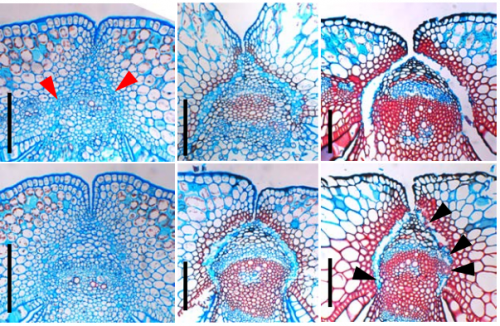
The power of model-to-crop translation illustrated by reducing seed loss from pod shatter in oilseed rape
Pauline Stephenson, Nicola Stacey, Marie Brüser, Nick Pullen, Muhammad Ilyas, Carmel O’Neill, Rachel Wells, Lars Østergaard
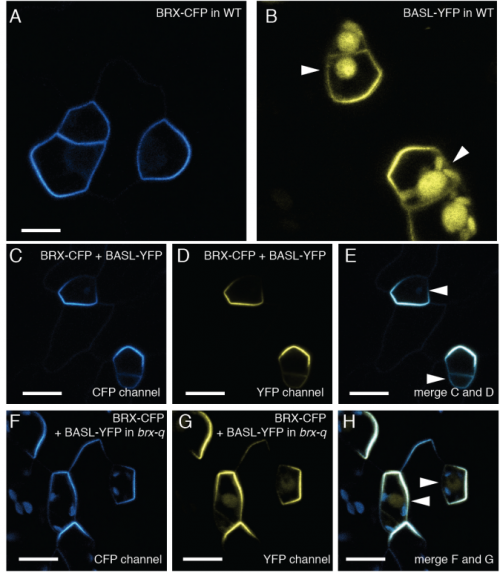
A Plant-Specific Polarity Module Establishes Cell Fate Asymmetry in the Arabidopsis Stomatal Lineage
Matthew H. Rowe, Juan Dong, Annika K. Weimer, Dominique C. Bergmann
SUPPRESSOR OF MAX2 1-LIKE 5 promotes secondary phloem formation during radial stem growth
Eva-Sophie Wallner, Virginie Jouannet, Thomas Greb
Spatiotemporal restriction of FUSCA3 expression by class I BPC promotes ovule development and coordinates embryo and endosperm growth
Jian Wu, Rosanna Petrella, Sebastian Dowhanik, Veronica Gregis, Sonia Gazzarrini
The receptor-like kinases BAM1 and BAM2 promote the cell-to-cell movement of miRNA in the root stele to regulate xylem patterning
Pengfei Fan, Hua Wang, Hao Xue, Tabata Rosas-Diaz, Weihua Tang, Heng Zhang, Lin Xu, Rosa Lozano-Duran
CrRLK1L receptor-like kinases HERCULES RECEPTOR KINASE 1 and ANJEA are female determinants of pollen tube reception
Sergio Galindo-Trigo, Noel Blanco-Touriñán, Thomas A. DeFalco, Eloise S. Wells, Julie E Gray, Cyril Zipfel, Lisa M Smith
Redistribution of NORTIA in response to pollen tube arrival facilitates fertilization in Arabidopsis thaliana
Jing Yuan, Yan Ju, Daniel S Jones, Weiwei Zhang, Noel Lucca, Christopher J Staiger, Sharon A Kessler
Identification of a role for an E6-like 1 gene in early pollen-stigma interactions in Arabidopsis thaliana
Jennifer Doucet, Christina Truong, Elizabeth Frank-Webb, Hyun Kyung Lee, Anna Daneva, Zhen Gao, Moritz Nowack, Daphne Goring

A microtubule-mediated mechanical feedback controls leaf blade development in three dimensions
Feng Zhao, Fei Du, Hadrien Oliveri, Lüwen Zhou, Olivier Ali, Wenqian Chen, Shiliang Feng, Qingqing Wang, Shouqin Lü, Mian Long, René Schneider, Arun Sampathkumar, Christophe Godin, Jan Traas, Yuling Jiao
Mechanical constraints influence microtubule orientation in plant cells
S Bachmann, R Froese, EN Cytrynbaum
The HAC1 Histone Acetyltransferase Promotes Leaf Senescence via Regulation of ERF022
Will E. Hinckley, Keykhosrow Keymanesh, Jaime A. Cordova, Judy A. Brusslan
Mapping and dynamics of regulatory DNA in maturing seeds
Alessandra M Sullivan, Andrej A Arsovski, Agnieszka Thompson, Richard Sandstrom, Robert E Thurman, Shane Neph, Audra K Johnson, Shawn T Sullivan, Peter J Sabo, Fidencio V Neri III, Molly Weaver, Morgan Diegel, Jennifer L Nemhauser, John A Stamatoyannopoulos, Kerry L Bubb, Christine Queitsch
Paternally-acting canonical RNA-directed DNA methylation pathway genes sensitize Arabidopsis endosperm to paternal genome dosage
P. R. V. Satyaki, Mary Gehring
Molecular framework for TIR1/AFB-Aux/IAA-dependent auxin sensing controlling adventitious rooting in Arabidopsis
Abdellah Lakehal, Salma Chaabouni, Emilie Cavel, Rozenn Le Hir, Alok Ranjan, Zahra Raneshan, Ondřej Novák, Daniel I. Păcurar, Irene Perrone, François Jobert, Laurent Gutierrez, Laszlo Bakò, Catherine Bellini
A role for the auxin precursor anthranilic acid in root gravitropism via regulation of PIN-FORMED protein polarity and relocalization in Arabidopsis
Siamsa M. Doyle, Adeline Rigal, Peter Grones, Michal Karady, Deepak K. Barange, Mateusz Majda, Barbora Pařízková, Michael Karampelias, Marta Zwiewka, Aleš Pěnčik, Fredrik Almqvist, Karin Ljung, Ondřej Novák, Stéphanie Robert

Xyloglucan homeostasis and microtubule dynamics synergistically maintain meristem geometry and robustness of phyllotaxis in Arabidopsis
Feng Zhao, Wenqian Chen, Julien Sechet, Marjolaine Martin, Simone Bovio, Claire Lionnet, Yuchen Long, Virginie Battu, Grégory Mouille, Françoise Monéger, Jan Traas
WRKY1 mediates transcriptional crosstalk between light and nitrogen signaling pathways in Arabidopsis thaliana
Sachin Heerah, Manpreet Katari, Rebecca Penjor, Gloria Coruzzi, Amy Marshall-Colon
A novel mutant allele uncouples brassinosteroid-dependent and independent functions of BRI1
Eleonore Holzwart, Nina Glöckner, Herman Höfte, Klaus Harter, Sebastian Wolf
Patronus is the elusive plant securin, preventing chromosome separation by antagonizing separase
Laurence Cromer, Sylvie Jolivet, Dipesh Kumar Singh, Floriane Berthier, Nancy De Winne, Geert De Jaeger, Shinichiro Komaki, Maria Ada Prusicki, Arp Schnittger, Raphael Guérois, Raphael Mercier
The Maize LINC KASH AtSINE-like2 (MLKS2) gene encodes an ARM domain protein that tethers the nucleus to F-actin and is required for normal development and meiotic chromosome segregation
Hardeep K Gumber, Joseph F McKenna, Andrea F Tolmie, Alexis M Jalovec, Andre C Kartick, Katja Graumann, Hank W Bass
Reconstructing the transcriptional ontogeny of maize and sorghum supports an inverse hourglass model of inflorescence development
Samuel Leiboff, Sarah Hake
The MADS-box transcription factor PHERES1 controls imprinting in the endosperm by binding to domesticated transposons
Rita A. Batista, Jordi Moreno-Romero, Joram van Boven, Yichun Qiu, Juan Santos-González, Duarte D. Figueiredo, Claudia Köhler
Reduced chromatin accessibility underlies gene expression differences in homologous chromosome arms of hexaploid wheat and diploid Aegilops tauschii
Fu-Hao Lu, Neil McKenzie, Laura-Jayne Gardiner, Ming-Cheng Luo, Anthony Hall, Michael W Bevan
GNI-A1 mediates trade-off between grain number and grain weight in tetraploid wheat
Guy Golan, Idan Ayalon, Aviad Perry, Gil Zimran, Toluwanimi Ade-Ajayi, Assaf Mosquna, Assaf Distelfeld, Zvi Peleg
Identification of a dominant chlorosis phenotype through a forward screen of the Triticum turgidum cv. Kronos TILLING population
Sophie A. Harrington, Nicolas Cobo, Miroslava Karafiatova, Jaroslav Dolezel, Philippa Borrill, Cristobal Uauy
Extension of the in vivo haploid induction system from maize to wheat
Chenxu Liu, Yu Zhong, Xiaolong Qi, Ming Chen, Zongkai Liu, Chen Chen, Xiaolong Tian, Jinlong Li, Yanyan Jiao, Dong wang, Yuwen Wang, Mengran Li, Mingming Xin, Wenxin Liu, Weiwei Jin, Shaojiang Chen
A Cys2/His2 zinc finger protein acts as a repressor of gibberellins biosynthesis by regulating SD1/OsGA20ox2 in rice (Oryza sativa L.)
Min Duan, Xiao-Juan Ke, Hong-Xia Lan, Xi Yuan, Peng Huang, En-Shun Xu, Xiu-Ying Gao, Ru-Qin Wang, Hai-Juan Tang, Hong-Sheng Zhang, Ji Huang
Impact of within-tree organ distances on floral induction and fruit growth in apple tree: implication of carbon and gibberellin organ contents
Farés Belhassine, Sébastien Martinez, Sylvie Bluy, Damien Fumey, Jean-Jacques Kelner, Evelyne Costes, Benoît Pallas
Evo-devo & evo

Pigeon foot feathering reveals conserved limb identity networks
Elena F. Boer, Hannah F. Van Hollebeke, Sungdae Park, Carlos R. Infante, Douglas B. Menke, Michael D. Shapiro
Frequent Non-random Shifts in the Temporal Sequence of Developmental Landmark Events during Teleost Evolutionary Diversification
Fumihiro Ito, Tomotaka Matsumoto, Tatsumi Hirata
Ancestral role of Fat-like cadherins in planar cell polarity
Maria Brooun, Alexander Klimovich, Mikhail Bashkurov, Bret J. Pearson, Robert E. Steele, Helen McNeill
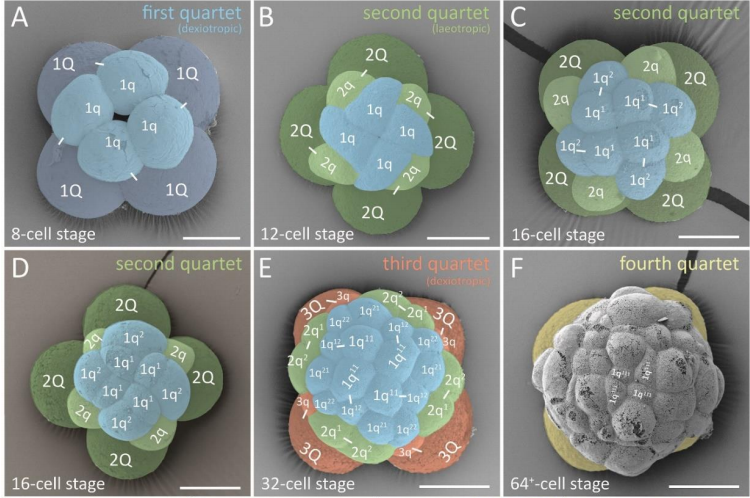
Studying early embryogenesis in the flatworm Maritigrella crozieri indicates a unique modification of the spiral cleavage program in polyclad flatworms
Johannes Girstmair, Maximilian J. Telford
Cell proliferation controls body size growth, tentacle morphogenesis, and regeneration in hydrozoan jellyfish Cladonema pacificum
Sosuke Fujita, Erina Kuranaga, Yuichiro Nakajima
Dorsoventral dissociation of Hox gene expression underpins the diversification of molluscs
Pin Huan, Qian Wang, Sujian Tan, Baozhong Liu
Active mode of excretion across digestive tissues predates the origin of excretory organs
Carmen Andrikou, Daniel Thiel, Juan A. Ruiz-Santiesteban, Andreas Hejnol
Fog signaling has diverse roles in epithelial morphogenesis in insects
Nadine Frey, Matthew A. Benton, Rodrigo Nunes da Fonseca, Cornelia von Levetzow, Dominik Stappert, Muhammad Salim Hakeemi, Kai H. Conrads, Matthias Pechmann, Kristen A. Panfilio, Jeremy A. Lynch, Siegfried Roth
Comparative transcriptomics analyses across species, organs and developmental stages reveal functionally constrained lncRNAs
Fabrice Darbellay, Anamaria Necsulea
Evolution of simple multicellular life cycles in dynamic environments
Yuriy Pichugin, Hye Jin Park, Arne Traulsen
Meta-population structure and the evolutionary transition to multicellularity
Caroline J. Rose, Katrin Hammerschmidt, Paul B. Rainey
Temperature preference does not evolve in sticklebacks despite multigenerational exposure to elevated temperatures
Natalie Pilakouta, Shaun S. Killen, Bjarni K. Kristjánsson, Skúli Skúlason, Jan Lindström, Neil B. Metcalfe, Kevin J. Parsons
Mapping of multiple complementary sex determination loci in a parasitoid wasp
Cyril Matthey-Doret, Casper J. van der Kooi, Daniel L. Jeffries, Jens Bast, Alice B. Dennis, Christoph Vorburger, Tanja Schwander
Two Y chromosome-encoded genes determine sex in kiwifruit
Takashi Akagi, Sarah M. Pilkington, Erika Varkonyi-Gasic, Isabelle M. Henry, Shigeo S. Sugano, Minori Sonoda, Alana Firl, Mark A. McNeilage, Mikaela J. Douglas, Tianchi Wang, Ria Rebstock, Charlotte Voogd, Paul Datson, Andrew C. Allan, Kenji Beppu, Ikuo Kataoka, Ryutaro Tao
Evolution of Yin and Yang isoforms of a chromatin remodeling subunit results in the creation of two genes
Wen Xu, Lijiang Long, Yuehui Zhao, Lewis Stevens, Ronald E. Ellis, Patrick T. McGrath
Within-population genome size variation is mediated by multiple genomic elements that segregate independently during meiosis
Claus-Peter Stelzer, Maria Pichler, Peter Stadler, Anita Hatheuer, Simone Riss
The ebb and flow of heteroplasmy during intra-species hybridization in Caenorhabditis briggsae
Shadi Adineh, Joseph Ross
Transcriptome Surveys in Silverfish Suggest a Multistep Origin of the Insect Odorant Receptor Gene Family
Michael Thoma, Christine Missbach, Melissa D. Jordan, Ewald Grosse-Wilde, Richard D. Newcomb, Bill S. Hansson
Dynamic chromosome rearrangements of the white-spotted bamboo shark shed light on cartilaginous fish diversification mechanisms
Yaolei Zhang, Haoyang Gao, Hanbo Li, Jiao Guo, Meiniang Wang, Qiwu Xu, Jiahao Wang, Meiqi Lv, Xinyu Guo, Qun Liu, Likun Wei, Han Ren, Yang Xi, Yang Guo, Qian Zhao, Shanshan Pan, Chuxin Liu, Liping Sang, Xiaoyan Ding, Chen Wang, Haitao Xiang, Yue Song, Yujie Liu, Shanshan Liu, Yuan Jiang, Changwei Shao, Jiahai Shi, Shiping Liu, Jamal S. M. Sabir, Mumdooh J. Sabir, Muhummadh Khan, Nahid H. Hajrah, Simon Ming-Yuen Lee, Xun Xu, Huanming Yang, Jian Wang, Guangyi Fan, Naibo Yang, Xin Liu
Cell biology
Spherical Spindle Shape Promotes Perpendicular Cortical Orientation by Preventing Isometric Cortical Pulling on both Spindle Poles during C. elegans Female Meiosis
Elizabeth Vargas, Karen P. McNally, Daniel B. Cortes, Michelle T. Panzica, Amy Shaub-Maddox, Francis J. McNally
Drosophila Snazarus regulates a lipid droplet population at plasma membrane-droplet contacts in adipocytes
Rupali Ugrankar, Jade Bowerman, Hanaa Hariri, Mintu Chandra, Kevin Chen, Marie-France Bossanyi, Sanchari Datta, Sean Rogers, Kaitlyn M. Eckert, Gonçalo Vale, Alexia Victoria, Joseph Fresquez, Jeffrey G. McDonald, Steve Jean, Brett M. Collins, W. Mike Henne
RhoA mediates epithelial cell shape changes via mechanosensitive endocytosis
Kate E. Cavanaugh, Michael F. Staddon, Ed Munro, Shiladitya Banerjee, Margaret L. Gardel
Basement membrane regulates fibronectin organization using sliding focal adhesions driven by a contractile winch
Jiaoyang Lu, Andrew D. Doyle, Yoshinari Shinsato, Shaohe Wang, Molly A. Bodendorfer, Minhua Zheng, Kenneth M. Yamada
Cell-projection pumping: A hydrodynamic cell-stiffness dependent mechanism for cytoplasmic transfer between mammalian cells
Hans Zoellner, Navid Paknejad, James Cornwell, Belal Chami, Yevgeniy Romin, Vitaly Boykov, Sho Fujisawa, Elizabeth Kelly, Garry W. Lynch, Glynn Rogers, Katia Manova, Malcolm A.S. Moore
WASP restricts active Rac to maintain cells’ front-rear polarisation
Clelia Amato, Peter Thomason, Andrew Davidson, Karthic Swaminathan, Shehab Ismail, Laura Machesky, Robert Insall
RhoG and Cdc42 can contribute to Rac-dependent lamellipodia formation through WAVE Regulatory Complex-binding
Matthias Schaks, Hermann Döring, Frieda Kage, Anika Steffen, Thomas Klünemann, Wulf Blankenfeldt, Theresia Stradal, Klemens Rottner
Snail induces epithelial cell extrusion through transcriptional control of RhoA contractile signaling and cell matrix adhesion
Kenneth Wee, Suroor Zadeh, Suzie Verma, Roger J. Daly, Alpha S. Yap, Melissa J. Davis, Srikanth Budnar
EMT-induced cell mechanical changes enhance mitotic rounding strength
Kamran Hosseini, Anna Taubenberger, Carsten Werner, Elisabeth Fischer-Friedrich
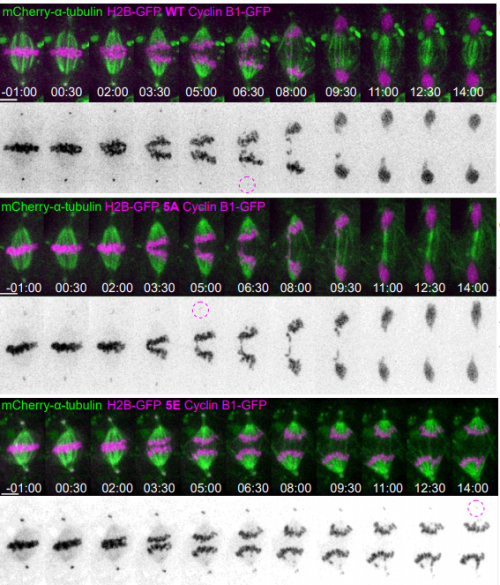
Mitotic exit is controlled during anaphase by an Aurora B-Cyclin B1/Cdk1 crosstalk
Olga Afonso, Liam P. Cheeseman, Luísa T. Ferreira, Eurico Morais-de-Sá, Helder Maiato
Direct transfer of a kinetochore between microtubules is fundamental to error correction mechanism
Harinath Doodhi, Taciana Kasciukovic, Marek Gierlinski, Shuyu Li, Lesley Clayton, Tomoyuki U. Tanaka
Re-configuration of Chromatin Structure During the Mitosis-G1 Phase Transition
Haoyue Zhang, Daniel J. Emerson, Thomas G. Gilgenast, Katelyn R. Titus, Yemin Lan, Peng Huang, Di Zhang, Hongxin Wang, Cheryl A. Keller, Belinda Giardine, Ross C. Hardison, Jennifer E Phillips-Cremins, Gerd A. Blobel
Microtubule glycylation promotes basal body attachment to the cell cortex
Anthony D. Junker, Adam W. J. Soh, Eileen T. O’Toole, Janet B. Meehl, Mayukh Guha, Mark Winey, Jerry E. Honts, Jacek Gaertig, Chad G. Pearson
RanGTP regulates cilium formation and ciliary trafficking of a kinesin-II subunit independent of its nuclear functions
Shengping Huang, Prachee Avasthi
Modelling
Isotropic expansion of external environment induces tissue elongation and collective cell alignment
H. Koyama, T. Fujimori
Modularity, criticality, and evolvability of a developmental gene regulatory network
Berta Verd, Nicholas AM Monk, Johannes Jaeger
Theoretical modeling on CRISPR-coded cell lineages: efficient encoding and optimal reconstruction
Ken Sugino, Jorge Garcia Marques, Isabel Espinosa Medina, Tzumin Lee
Robust Reconstruction of CRISPR and Tumor Lineage Using Depth Metrics
Ken Sugino, Tzumin Lee
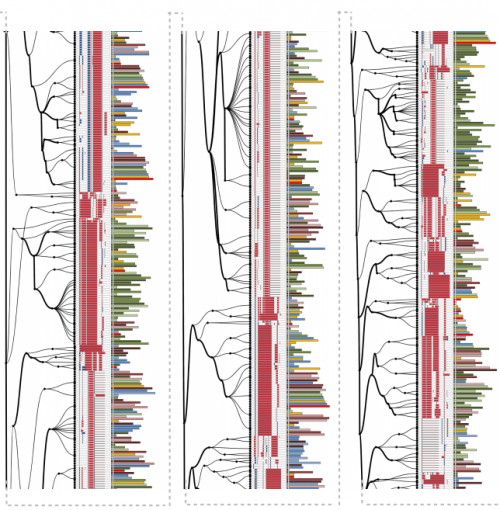
Estimation of cell lineage trees by maximum-likelihood phylogenetics
Jean Feng, William S DeWitt III, Aaron McKenna, Noah Simon, Amy Willis, Frederick A Matsen IV
Modeling tumorspheres reveals cancer stem cell niche building and plasticity
L. Benítez, L. Barberis, C. A. Condat
Morphogenesis Software based on Epigenetic Code Concept
N. Bessonov, O.Butuzova, A.Minarsky, R. Penner, C. Soule, A. Tosenberger, N. Morozova
Seeding hESCs to achieve optimal colony clonality
Laura E Wadkin, Sirio Orozco-Fuentes, Irina Neganova, Sanja Bojic, Alex Laude, Majlina Lako, Nicholas G Parker, Anvar Shukurov
Mechanical constraints influence microtubule orientation in plant cells
Sven Bachmann, Richard Froese, Eric N Cytrynbaum
The role of network topology, growth laws and mechanics in the dynamics of cell assemblies
Alexander Erlich, Gareth W. Jones, Françoise Tisseur, Derek E. Moulton, Alain Goriely
An Analytical Theory of Cellular Growth
Hugo Dourado, Martin J. Lercher
An individual-based mechanical model of cell movement in heterogeneous tissues and its coarse-grained approximation
R. J. Murphy, P. R. Buenzli, R. E. Baker, M. J. Simpson
Cross-talk between Hippo and Wnt signalling pathways in intestinal crypts: insights from an agent-based model
Daniel Ward, Alexander G. Fletcher, Martin Homer, Lucia Marucci
The FLAME-accelerated Signalling Tool (FaST): A tool for facile parallelisation of flexible agent-based models of cell signalling
Gavin Fullstone, Cristiano Guttà, Amatus Beyer, Markus Rehm
Modeling enamel matrix secretion in mammalian teeth
Teemu J. Häkkinen, S. Susanna Sova, Ian J. Corfe, Leo Tjäderhane, Antti Hannukainen, Jukka Jernvall
Cell fate determination by Lamarckian molecule-inheritance and chance
Frank J. Bruggeman, Jaap Schouten, Daan H. de Groot, Robert Planqué
Tools & resources

Identification of neuronal lineages in the Drosophila peripheral nervous system with a novel multi-spectral lineage tracing system
Macy W. Veling, Ye Li, Mike T. Veling, Christopher Litts, Nigel Michki, Hao Liu, Dawen Cai, Bing Ye
Differential Expression Gene Explorer (DrEdGE): A tool for generating interactive online data visualizations for exploration of quantitative transcript abundance datasets
Sophia C. Tintori, Patrick Golden, Bob Goldstein
DNA barcoding reveals that injected transgenes are predominantly processed by homologous recombination in mouse zygote
Alexander Smirnov, Anastasia Yunusova, Alexey Korablev, Irina Serova, Veniamin Fishman, Nariman Battulin
Enabling large-scale genome editing by reducing DNA nicking
Cory J. Smith, Oscar Castanon, Khaled Said, Verena Volf, Parastoo Khoshakhlagh, Amanda Hornick, Raphael Ferreira, Chun-Ting Wu, Marc Güell, Shilpa Garg, Hannu Myllykallio, George M. Church
Heat-triggered remote control of CRISPR-dCas9 for tunable transcriptional modulation
Lena Gamboa, Erick V. Phung, Haoxin Li, Jared P. Meyers, Gabriel A. Kwong
Suppression of unwanted CRISPR/Cas9 editing by co-administration of catalytically inactivating truncated guide RNAs
John C. Rose, Nicholas A. Popp, Christopher D. Richardson, Jason J. Stephany, Julie Mathieu, Cindy T. Wei, Jacob E. Corn, Dustin J. Maly, Douglas M. Fowler
Multiplexed and Inducible Gene Modulation in Human Pluripotent Stem Cells by CRISPR Interference and Activation
Dane Z. Hazelbaker, Amanda Beccard, Patrizia Mazzucato, Gabriella Angelini, Angelica Messana, Daisy Lam, Kevin Eggan, Lindy E. Barrett
Fast and cloning-free CRISPR/Cas9-mediated genomic editing in mammalian cells
Paul T. Manna, Luther J. Davis, Margaret S. Robinson

A simple and efficient CRISPR technique for protein tagging
Fanning Zeng, Valerie Beck, Sven Schuierer, Isabelle Garnier, Carole Manneville, Claudia Agarinis, Lapo Morelli, Lisa Quinn, Judith Knehr, Guglielmo Roma, Frederic Bassilana, Mark Nash
A Pandas complex adapted for piRNA-guided transposon silencing
Kang Zhao, Sha Cheng, Na Miao, Ping Xu, Xiaohua Lu, Ming Wang, Yuhan Zhang, Xun Yuan, Weiwei Liu, Xin Lu, Xuan Ouyang, Peng Zhou, Jiaqi Gu, Yiqun Zhang, Ding Qiu, Shan Wang, Zhaohui Jin, Youzhong Wan, Jinbiao Ma, Ying Huang, Yang Yu
ORF Capture-Seq: a versatile method for targeted identification of full-length isoforms
Gloria M. Sheynkman, Katharine S. Tuttle, Elizabeth Tseng, Jason G. Underwood, Liang Yu, Da Dong, Melissa L. Smith, Robert Sebra, Tong Hao, Michael A. Calderwood, David E. Hill, Marc Vidal
The full-length transcriptome of C. elegans using direct RNA sequencing
Nathan P. Roach, Norah Sadowski, Amelia F. Alessi, Winston Timp, James Taylor, John K. Kim
Decoding neuronal diversity by single-cell Convert-seq
Joachim Luginbühl, Tsukasa Kouno, Rei Nakano, Thomas E Chater, Divya M Sivaraman, Mami Kishima, Filip Roudnicky, Piero Carninci, Charles Plessy, Jay W Shin
Optimal marker gene selection for cell type discrimination in single cell analyses
Bianca Dumitrascu, Soledad Villar, Dustin G. Mixon, Barbara E. Engelhardt
dropClust2: An R package for resource efficient analysis of large scale single cell RNA-Seq data
Debajyoti Sinha, Pradyumn Sinha, Ritwik Saha, Sanghamitra Bandyopadhyay, Debarka Sengupta
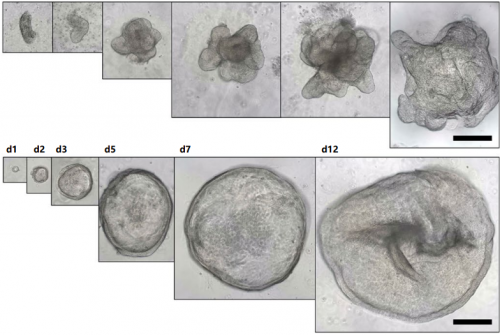
Congruence of location-specific transcriptional programs in intestinal organoids during long-term culture
Bart van der Hee, Ole Madsen, Hauke Smidt, Jerry M Wells
A simplified transposon mutagenesis method to perform phenotypic forward genetic screens in cultured cells
Charlotte R. Feddersen, Lexy S. Wadsworth, Eliot Y. Zhu, Hayley R. Vaughn, Andrew P. Voigt, Jesse D. Riordan, Adam J. Dupuy
High-throughput, image-based flow cytometry and clustering method for phenotyping heterogeneous cell populations
Robert Peuß, Andrew C. Box, Alice Accorsi, Christopher Wood, Alejandro Sánchez Alvarado, Nicolas Rohner
A reference map of the human protein interactome
Katja Luck, Dae-Kyum Kim, Luke Lambourne, Kerstin Spirohn, Bridget E. Begg, Wenting Bian, Ruth Brignall, Tiziana Cafarelli, Francisco J. Campos-Laborie, Benoit Charloteaux, Dongsic Choi, Atina G. Cote, Meaghan Daley, Steven Deimling, Alice Desbuleux, Amélie Dricot, Marinella Gebbia, Madeleine F. Hardy, Nishka Kishore, Jennifer J. Knapp, István A. Kovács, Irma Lemmens, Miles W. Mee, Joseph C. Mellor, Carl Pollis, Carles Pons, Aaron D. Richardson, Sadie Schlabach, Bridget Teeking, Anupama Yadav, Mariana Babor, Dawit Balcha, Omer Basha, Christian Bowman-Colin, Suet-Feung Chin, Soon Gang Choi, Claudia Colabella, Georges Coppin, Cassandra D’Amata, David De Ridder, Steffi De Rouck, Miquel Duran-Frigola, Hanane Ennajdaoui, Florian Goebels, Liana Goehring, Anjali Gopal, Ghazal Haddad, Elodie Hatchi, Mohamed Helmy, Yves Jacob, Yoseph Kassa, Serena Landini, Roujia Li, Natascha van Lieshout, Andrew MacWilliams, Dylan Markey, Joseph N. Paulson, Sudharshan Rangarajan, John Rasla, Ashyad Rayhan, Thomas Rolland, Adriana San-Miguel, Yun Shen, Dayag Sheykhkarimli, Gloria M. Sheynkman, Eyal Simonovsky, Murat Taşan, Alexander Tejeda, Jean-Claude Twizere, Yang Wang, Robert J. Weatheritt, Jochen Weile, Yu Xia, Xinping Yang, Esti Yeger-Lotem, Quan Zhong, Patrick Aloy, Gary D. Bader, Javier De Las Rivas, Suzanne Gaudet, Tong Hao, Janusz Rak, Jan Tavernier, Vincent Tropepe, David E. Hill, Marc Vidal, Frederick P. Roth, Michael A. Calderwood
A genetically-encoded toolkit of functionalized nanobodies against fluorescent proteins for visualizing and manipulating intracellular signalling
David L. Prole, Colin W. Taylor
tagPAINT: Stoichiometric and covalent labelling of protein tags for multiplexed and quantitative DNA-PAINT imaging
Daniel J. Nieves, Geva Hilzenrat, Jason Tran, Zhengmin Yang, Hugh H. MacRae, Matthew A. B. Baker, J Justin Gooding, Katharina Gaus
Imaging chromatin interactions at sub-kilobase resolution Via Tn5-FISH
Xu Zhang, Jing Niu, Guipeng Li, Qionghai Dai, Dayong Jin, Juntao Gao, Michael Q. Zhang
An enhanced molecular tension sensor based on bioluminescence resonance energy transfer (BRET)
Eric J. Aird, Kassidy J. Tompkins, Wendy R. Gordon
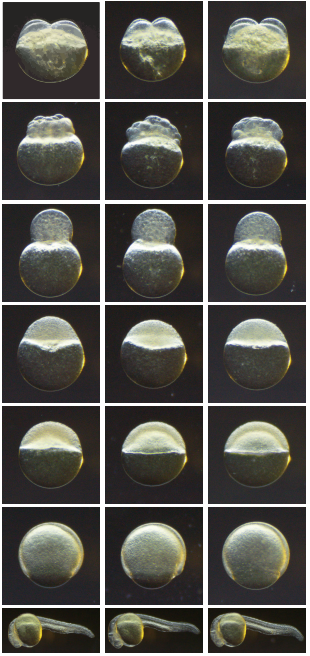
Quantitative measurements of chromatin modification dynamics during zygotic genome activation
Yuko Sato, Lennart Hilbert, Haruka Oda, Yinan Wan, John M. Heddleston, Teng-Leong Chew, Vasily Zaburdaev, Philipp Keller, Timothee Lionnet, Nadine Vastenhouw, Hiroshi Kimura
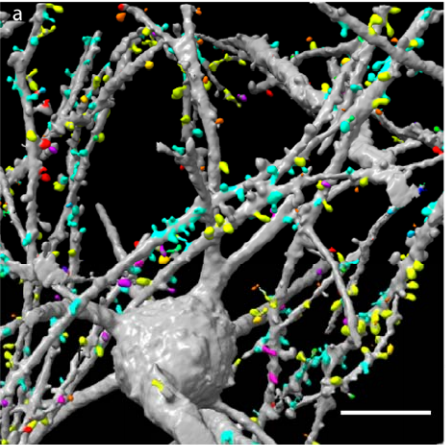
Light-sheet microscopy with isotropic, sub-micron resolution and solvent-independent large-scale imaging
Tonmoy Chakraborty, Meghan Driscoll, Malea Murphy, Philippe Roudot, Bo-Jui Chang, Saumya Vora, Wen Mai Wong, Cara Nielson, Hua Zhang, Vladimir Zhemkov, Chitkale Hiremath, Estanislao Daniel De La Cruz, Ilya Bezprozvanny, Hu Zhao, Raju Tomer, Rainer Heintzmann, Julian Meeks, Denise Marciano, Sean Morrison, Gaudenz Danuser, Kevin M. Dean, Reto Fiolka
Rapid 3D enhanced resolution microscopy reveals the dynamics of cortical dendritic spinules
CR Zaccard, K Myczek, MD Martin-de-Saavedra, P Penzes
3D Multicolor Nanoscopy at 10,000 Cells a Day
Andrew E S Barentine, Yu Lin, Miao Liu, Phylicia Kidd, Leonhard Balduf, Michael R Grace, Siyuan Wang, Joerg Bewersdorf, David Baddeley
EpiGraph: an open-source platform to quantify epithelial organization
Pablo Vicente-Munuera, Pedro Gómez-Gálvez, Robert J. Tetley, Cristina Forja, Antonio Tagua, Marta Letrán, Melda Tozluoglu, Yanlan Mao, Luis M. Escudero
DLITE uses cell-cell interface movement to better infer cell-cell tensions
Ritvik Vasan, Mary M Maleckar, Charles David Williams, Padmini Rangamani
Research practice & education
Co-reviewing and ghostwriting by early career researchers in the peer review of manuscripts
Gary S. McDowell, John Knutsen, June Graham, Sarah K. Oelker, Rebeccah S. Lijek
Gender and international diversity improves equity in peer review
Dakota Murray, Kyle Siler, Vincent Larivière, Wei Mun Chan, Andrew M. Collings, Jennifer Raymond, Cassidy R. Sugimoto
The ELIXIR Core Data Resources: fundamental infrastructure for the life sciences
Rachel Drysdale, Charles E Cook, Robert Petryszak, Vivienne Baillie Gerritsen, Mary Barlow, Elisabeth Gasteiger, Franziska Gruhl, Juergen Haas, Jeremy Lanfear, Rodrigo Lopez, Nicole Redaschi, Heinz Stockinger, Daniel Teixeira, Aravind Venkatesan, ELIXIR Core Data Resource Forum, Niklas Blomberg, Christine Durinx, Jo McEntyre
Moving beyond P values: Everyday data analysis with estimation plots
Joses Ho, Tayfun Tumkaya, Sameer Aryal, Hyungwon Choi, Adam Claridge-Chang
Tracking the popularity and outcomes of all bioRxiv preprints
Richard J. Abdill, Ran Blekhman
Abandoning statistical significance is both sensible and practical
Valentin Amrhein, Andrew Gelman, Sander Greenland, Blakeley B McShane
Use of the Journal Impact Factor in academic review, promotion, and tenure evaluations
Erin C. McKiernan, Lesley A. Schimanski, Carol Muñoz Nieves, Lisa Matthias, Meredith T. Niles, Juan Pablo Alperin
Why not…
Morphogenesis and dynamics of slime molds in various environments
Fernando Patino-Ramirez, Aurèle Boussard, Chloé Arson, Audrey Dussutour
Not dead yet: Diatom resting spores can survive in nature for several millennia
Anushree Sanyal, Josefine Larsson, Falkje van Wirdum, Thomas Andrén, Matthias Moros, Mikael Lönn, Elinor Andrén
Left-handedness is associated with greater fighting success in humans
Thomas Richardson, Tucker Gilman


 (No Ratings Yet)
(No Ratings Yet) (1 votes)
(1 votes)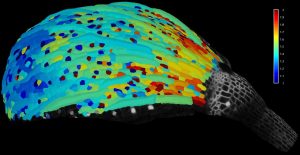




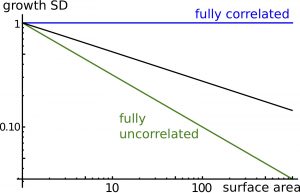
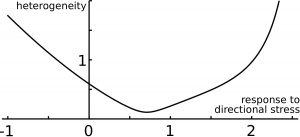
 (5 votes)
(5 votes)